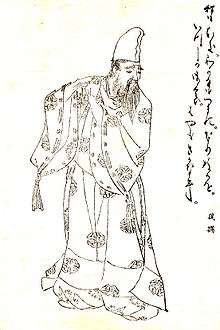Fujiwara no Saneyori
Fujiwara no Saneyori (藤原 実頼, 900 – June 24, 970), also known as Onomiya-dono, was a Japanese statesman, courtier and politician during the Heian period.[1]
Fujiwara no Saneyori 藤原実頼 | |
|---|---|
 Illustration by Kikuchi Yōsai, from Zenken Kojitsu | |
| Imperial Regent of Japan | |
| In office July 31, 967 – June 24, 970 | |
| Monarch | Reizei En'yū |
| Preceded by | Fujiwara no Tadahira |
| Succeeded by | Fujiwara no Koretada |
| Personal details | |
| Born | 900 |
| Died | June 24, 970 (aged 69–70) Heian Kyō (Kyōto) |
| Parents | Fujiwara no Tadahira (father) Minamoto no Junshi (mother) |
Career
He was a minister during the reigns of Emperor Reizei and Emperor En'yū.[1]
- May 4, 944 (Tengyō 7, 9th day of the 4th month): Saneyori was elevated to the position of udaijin in the Imperial court hierarchy.[2]
- May 19, 947 (Tenryaku 1, 26th day of the 4th month): Saneyori is promoted to the positions of sadaijin and grand general of the left.[3]
- 949 (Tenryaku 3, 1st month): Saneyori and his brother Morosuke shared the duties of daijō-daijin during a period of Fujiwara no Tadahira's ill-health.[3]
- 958 (Tentoku 2, 3rd month): Saneyori was granted special permission to travel in a wheeled vehicle.[4]
- March 26, 963 (Ōwa 3, 28th day of the 2nd month): Saneyori presided at the coming of age ceremonies for Norihira-shinnō (憲平親王) who would later become Emperor Reizei.[5]
- July 31, 967 (Kōhō 4, 22nd day of the 6th month): Saneyori began serving as kampaku when Emperor Reizei assumed the throne in 967.
- September 27, 969 (Anna 2, 13th day of the 8th month): Saneyori was appointed sesshō (regent).
- June 24, 970 (Tenroku 1, 18th day of the 5th month): Saneyori died at age 70; and he was posthumously elevated to the first class in rank.[6]
After his death, Saneyori's nephew Koretada assumed his duties when he was named sesshō after his death.[7]
Genealogy
This member of the Fujiwara clan was the son of Fujiwara no Tadahira.[1] Saneyori was the eldest son.[2] He had two brothers: Morosuke and Morotada.[8]
Notes
- Nussbaum, Louis-Frédéric. (2005). "Fujiwara no Saneyori" in Japan Encyclopedia, p. 208, p. 208, at Google Books; Brinkley, Frank et al. (1915). A History of the Japanese People from the Earliest Times to the End of the Meiji Era, pp. 203, 259., p. 203, at Google Books
- Titsingh, Isaac. (1834). Annales des empereurs du japon, p. 138, p. 138, at Google Books; see "Fousiwara-no Sane yori", pre-Hepburn romanization
- Titsingh, p. 139, p. 139, at Google Books.
- Titsingh, p. 140, p. 140, at Google Books.
- Titsingh, p. 141, p. 141, at Google Books.
- Titsingh, p. 144, p. 144, at Google Books.
- Brinkley, p. 259, p. 259, at Google Books; Titsingh, p. 144., p. 144, at Google Books
- Brinkley, p. 257, p. 257, at Google Books.
gollark: ```coqTheorem gollarks_alts : forall (alt : Tux1), owner alt = gollark.Proof. intro. simpl. reflexivity. Qed.```
gollark: Give me a minute.
gollark: Okay, I can do this mathematically.
gollark: https://wiki.mondecitronne.com/wiki/POOT-421I mean, *really*?
gollark: You totally are. Nobody but my alt would be so ridiculous as to write insults about people into Wiki Encyclopaedia.
References
- Brinkley, Frank and Dairoku Kikuchi. (1915). A History of the Japanese People from the Earliest Times to the End of the Meiji Era. New York: Encyclopædia Britannica. OCLC 413099
- Nussbaum, Louis-Frédéric and Käthe Roth. (2005). Japan encyclopedia. Cambridge: Harvard University Press. ISBN 978-0-674-01753-5; OCLC 58053128
- Titsingh, Isaac. (1834). Nihon Odai Ichiran; ou, Annales des empereurs du Japon. Paris: Royal Asiatic Society, Oriental Translation Fund of Great Britain and Ireland. OCLC 5850691
This article is issued from Wikipedia. The text is licensed under Creative Commons - Attribution - Sharealike. Additional terms may apply for the media files.